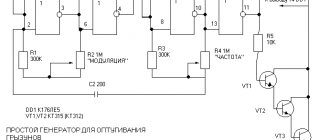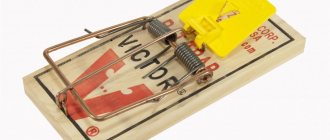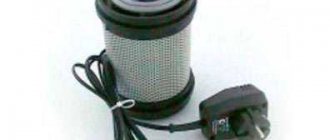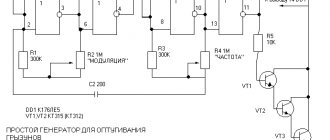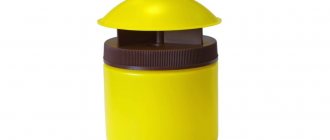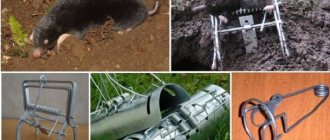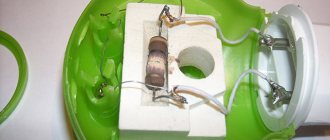Mice are often found in a person’s home, regardless of where he lives - in an apartment or in a private house. These rodents climb to the upper floors of multi-story high-rise buildings. The results of their vital activity are constant rustling and squeaking at night, damaged food, chewed things, and electrical wires. As a rule, most owners prefer inhumane methods of control, using toxic substances.
Some owners, on the contrary, are more inclined to humane methods of control, catching rodents without mousetraps, using homemade traps of various designs. As a rule, such traps are made from unnecessary materials, without wasting time and money. At the same time, there are many circuits of simple devices available to manufacture.
Why do mice appear?
As a rule, mice try to move closer to humans when winter is approaching, and when it’s warm outside, they feel great in the field, where there is plenty of food. With the onset of winter, they rely on the fact that food can be obtained from a person who is stocking up on food for the winter.
Besides this main reason, there are others. For example:
- Unsanitary conditions in the house when there is free access to leftover food.
- Storing food in improper form, as well as in places not intended for this.
- The presence of holes and cracks in the area of baseboards, sewer pipes and water supply pipes.
- The presence of old unnecessary things that are stored in a separate room.
- The presence of a garbage dump not far from the house.
- Free access to water.
- Failure to empty trash bins in a timely manner.
- The presence of flour and cereal residues scattered in kitchen cabinets.
How to catch a live mouse
Most people would prefer to catch a rodent without a mousetrap, without killing it, and then release it away from their home, giving it freedom and life.
Methods for catching mice:
- The easiest way is to catch mice at home in a glass jar with a capacity of 0.5 liters or 1 liter. The bait is glued to its bottom, turned over with the hole down and placed with the edge on the edge of the coin. When the mouse tries to get food, it crawls inside, the coin falls, and the jar covers the prey. Similarly, you can use a flower pot and other suitable container as a .
- To either use a trap made from a plastic bottle - bait is placed inside it, and a thread is tied to the neck. The bottle must be hung in such a way that the bottom hangs and can be rested on the edges of the shelf. For free access, a board is placed on which the rodent will climb inside, then the bottle hangs on a rope from a push. It will be impossible for a mouse to get out of the bottle.
- A trap is made from a shoebox, and the bait is attached to the center with a rope. It is turned upside down, the bait should hang on a thread. The edges are placed on supports: matches or pieces of cardboard. Due to the instability of the structure, when the pest tries to get to the food, the box will fall and cover it.
- To catch a mouse in the house, you can make a trap from a bucket with a spinning bottle: for this you will need a 0.5 liter plastic bottle, which you need to pierce with a knitting needle through the bottom and lid. The knitting needle needs to be secured to the top of a standing bucket, and tasty food should be spread on the bottle. The mouse climbs to the top of the bucket along the attached plank, tries to reach the bait, the bottle spins, and the rodent falls down. It is better to pour some water into the bucket, as it will be harder for a wet animal to get out.
- The design is made from a standing three-liter jar in which treats are placed at the bottom. So that the mouse can climb up, they build a ladder from a stack of books. Having climbed up the books, she jumps into a jar for food, but will not be able to get back out.
In stores you can also find mousetrap designs that do not kill, but only help catch animals.
A ready-made house for catching rodents or a live trap is a type of mousetrap. Its difference is that the animal comes inside, trying to take the bait, pulls the wire: the mechanism is triggered, and the door quickly slams shut. The mouse is caught, all that remains is to get it out of there and release it into the wild.
You can catch mice using a self-made box made of metal mesh squares held together with wire. The door is made on one of the sides, opens from top to bottom and is attached to a spring to which a thread with bait is tied. Pulling on a piece of food, the mouse pulls the thread, breaks it, and the door slams shut.
On a note!
Recently, house mousetraps made of galvanized wire mesh have appeared on sale; they look like a small inverted colander with a lid. There is a wire hole made in them at the top, through which the rodent climbs in for a tasty, aromatic bait, but can no longer get out. The caught animal is released into nature, away from home. The design can be used repeatedly.
What damage can mice cause?
Even one mouse can cause significant harm, and if several of them sneak into your home, this is an emergency. In addition to the fact that mice cause harm, many housewives are also afraid of them, causing panic in the house or apartment when they accidentally appear. Often these people have high blood pressure due to nervous stress, which can lead to heart attacks.
As a result of the vital activity of mice, you can count on the following consequences:
- Infection with dangerous diseases is possible, since rodents are carriers of dangerous microorganisms.
- The possibility of a fire in a house or apartment as a result of a short circuit due to damage to the insulation of the electrical wiring.
- Damage to food and household property.
- The presence of an unpleasant odor in the home from the results of their vital activity.
Signs of rodents in a house or apartment
When a person is in an apartment or house, mice rest quietly in secluded places, waiting for the person to either leave the home to do his business or go to sleep. That's when they begin to show their activity, which is expressed in squeaking, scratching or rustling. If you wake up at night and do not immediately get out of bed, but try to lie down and listen, then the presence of rodents will be detected. At the same time, there are other signs that indicate such an unpleasant neighborhood.
You need to pay attention to the following:
- Gnawed food remains.
- The presence of excrement on the floor, on the table, as well as among food supplies.
- A peculiar “mouse” smell appears in the home, which is difficult to confuse with any other smell.
- Damaged packaging such as sacks, cereal or flour bags, or boxes of cookies or cereal.
- Presence of holes in the baseboard area.
Mice actively migrate and enter apartments through the ventilation system, as well as through various cracks or leaks in the floor and other parts of the house or apartment. Mice have no problem chewing holes in wood and other structures. They can be stopped by metal, brick or concrete.
Method number 3: plastic bottle
How to catch a mouse in the house using a plastic bottle? In addition to the container itself, you will need thread and bait.
Sequencing:
- Bait is thrown to the bottom.
- The bottle is placed on the edge of the table so that the bottom hangs down.
- One edge of the thread or fishing line is securely fastened to the table, the second is tied to the neck.
The bottle, under the gravity of a rodent who decides to feast on it, will turn over and the mouse will have nothing left to do but dangle in the air, awaiting its fate.
How to catch a mouse in an apartment or house without a mousetrap using a plastic bottle, an eraser, a paper clip and two plastic or wooden tubes:
- A small hole is cut in the center of the bottom.
- The top is cut at a certain distance (¼) from the neck so that an improvised lid is obtained.
- One tube is threaded through the center of the bottle, the second through the center of the “cap”.
- The bait is threaded onto a paper clip with an elastic band and threaded through the drilled hole, the second end of the elastic band is secured on the outside of the cork.
- The second rubber band is attached to the outside of the bottle on the tubes so that the “lid” is open.
Operating principle: from the tension created by the mouse pulling the bait, the first elastic band will break and the lid will slam shut.
Humane methods of control using homemade traps
You can get rid of mice in your apartment using homemade traps, without resorting to the use of toxic substances or traps. At the same time, despite their simplicity, the designs have a noticeable effect.
Various, sometimes unnecessary items are suitable for making such devices, and vegetable oil, seeds or cheese are suitable as bait. As a result of such efforts, the rodents remain alive; all that remains is to take them out and release them somewhere away from housing so that they cannot return.
Plastic bottle traps
Nowadays, getting a plastic bottle of any capacity is not difficult, all that remains is to do the following manipulations with it:
- To make a trap, a plastic bottle with a capacity of 1.5-2 liters, the top part with the neck of which is cut off, is more suitable.
- A container without a neck, from the bottom to the top from the inside, is generously lubricated with vegetable oil, preferably unrefined.
- In addition, a layer of the same oil, about 2 cm thick, is poured onto the bottom and a layer of seeds is poured.
- A trap equipped in this way is installed in a place where mice “like” to host. A special “ladder” made of wood should be attached to the bottle so that mice can climb it to the top point.
- The bottle can be installed either at an angle or straight. The main thing is that the mouse cannot escape from the trap.
- The container must be fixed in a stationary position.
- The trap is set in the evening, and in the morning, if there is a mouse in it, the latter must be taken and released, somewhere on the street or in the yard.
Mousetrap using improvised means
Glass jar trap
Preparation method:
- To do this, you need to take a jar with a capacity of about 1 liter, a small piece of cheese, narrow tape and a coin.
- First you need to secure a piece of cheese with tape to the bottom of the jar.
- It is necessary to ensure that the cheese, if you turn the jar over, does not reach the base of the surface by about 5 cm.
- The trap is set next to the mouse hole or in another place. To do this, the jar is turned over and placed on an incline using a coin. Installing the trap requires some care, since the design is minimally stable.
MOUSETRAP from a JAR or HOW TO CATCH ALL THE MICE
Ultrasonic repellers
Thanks to the achievements of modern science and technology, it has been possible to develop devices that generate ultrasonic waves. Humans do not perceive ultrasound, but most animals perceive these waves, so their behavior may depend on the action of such waves. As you know, there are ultrasonic whistles for giving commands to dogs. Sound waves in this range have different effects on animals, including rodents. A certain power of ultrasound causes panic and fear in mice, after which they try to leave the area of the device as quickly as possible.
Nowadays, it is not difficult to choose a product, depending on the specific conditions of use, as well as depending on financial capabilities. Moreover, there is no need to catch mice, since they themselves will go in search of more comfortable conditions for their livelihoods.
To solve this issue, just go to a store that sells ultrasonic rodent repellers. As a rule, these are not expensive and compact devices. All that remains is to decide which device to purchase. To do this, it is better to pay attention to the following factors:
- A good device has the function of adjusting the frequency of the output signal. The fact is that over time, rodents begin to get used to one signal frequency. Some models are capable of changing the ultrasound frequency automatically after a certain period of time.
- For better efficiency, it is better to purchase several devices in order to cover the problem areas of the apartment as much as possible. The fact is that ultrasound does not spread if there is an obstacle in its path, in the form of upholstered furniture or thick curtains.
- Be sure to read the instructions to understand how versatile the device is and whether it can work in conditions of temperature fluctuations. This is necessary so that the device can be used in outbuildings that are not heated.
- If you buy, then a high-quality, universal device, which naturally costs more than some cheap device of dubious origin.
- Where an ultrasonic repeller is installed, it makes no sense to install additional traps, especially with bait that will attract rodents.
- The device should only be used under the conditions described in the instructions, which can guarantee its trouble-free operation.
Note to everyone! If you keep decorative rodents at home, such as hamsters and guinea pigs, then using ultrasound is not recommended, since they will experience the same thing as real pests.
The following products can be offered for use against mice:
- Typhoon.
- Range.
- Hail.
- Sonar.
- Electric cat.
- Tornado.
- Pest Reject.
Ultrasonic rodent repeller // How does it work? // Review and anti-test drive) Life in the village
Best mouse bait
When wondering how to catch a mouse, you need to decide on bait. To attract the attention of the rodent, a treat is selected. This is not cheese, as is commonly believed. Although it emits a strong odor, rodents only eat it when they are very hungry. If this happens, the mouse will not go into the cage for cheese, but will make do with the available options - paper, soap, wooden thresholds.
In nature, mice eat plant foods, and cereals are considered especially tasty. Rats eat eggs and meat.
If you want to lure a rat, use a small piece of meat or egg; for mice, add grain.
If you don’t know exactly who is in your house, it’s better to put a slice of bread, nuts, and dried apples.
A universal means of catching lard is lard, but not every product will do. It is important to place fresh and soft bait. To ensure that the lard has a pronounced aroma, heat it over an open fire. If this is not the case, take a slice of bread soaked in oil (sesame is good, but sunflower is also suitable).
Liver products used as bait:
- apple;
- pear;
- plum;
- peach;
- nuts;
- corn;
- buckwheat or rice groats;
- sunflower seeds.
Important! When using a glue mouse trap at home, no additional luring products are needed. The product is already impregnated with fragrances that attract pests. For another type - a trap - seeds, flour or wheat grains are suitable.
Useful tips
Mice appear where there is something to eat, and food can always be found in a person’s home, especially in conditions where the owners themselves create conditions where there is free access to food. Many owners complain that it is almost impossible to deal with rodents, no matter what control methods are used against them. All methods are good if the goal is to get rid of such a neighborhood. In order not to waste time and money fighting rodents, you can try to prevent their appearance. How to proceed:
- Do not allow the house or apartment to be in chaos.
- The trash can must be closed and its contents must be disposed of in a timely manner.
- Store bulk food products exclusively in special containers with lockable lids.
- Do not leave food on the dining table.
- Do not leave the bread bin open.
- After eating, immediately remove leftover food from the table.
- Seal all holes and cracks in the floor, as well as around the baseboards.
- Ensure that waste is removed on time by the appropriate services.
- Use all means of control to prevent rodents from entering outbuildings.
Many owners prefer humane methods of control, but one should always remember that this method does not reduce the population of rodents, which can reproduce at enormous rates. In addition, it is necessary to spend a lot of time to remove the animal and release it. You need to take it away from the house or apartment so that this animal does not come back. Although, on the other hand, not everyone is ready to use toxic substances in their home. In order not to waste time catching mice, it is better to pay attention to the technical and sanitary condition of the building. It is quite possible that some habits will have to be abandoned once and for all. And there are a lot of bad habits that help create conditions for not only mice, but also other pests to appear in the apartment.
At the first suspicion of the presence of rodents, you can try making a simple trap from a plastic bottle. This is not only effective, but also economical. If this is done in time, then there will be no trace left of such a neighborhood.
The simplest and most effective mouse trap. Getting rid of pests in the garden and in the house.
How to catch a mouse
It's easier to fight a pest when you know what it is.
Table: distinctive features of mice
A medium-sized animal can easily slip into a round slot with a diameter of about a centimeter and, in an extreme situation, jump up to one meter in length.
The fight against domestic rodents includes the use of spring mousetraps, glue traps, various types of repellers, and poisoned baits. At the same time, people have to change tactics all the time, inventing new devices. Live traps are the most humane means of getting rid of rodents and are quite easy to make with your own hands from scrap materials.
Humane plastic bottle mouse trap
To make such a trap you will need a plastic bottle, rope, a heavy object and bait. The rope must be tied to the neck.
The rope must be of sufficient length
We put bait in the bottle. Mice are most attracted to foods with a strong aroma, but smelly chemical additives likely won't work.
It is better to use natural products as bait
The bottle should be placed on the edge of a table or other surface. We fix the end of the rope using a heavy object.
Homemade mouse live trap installed and ready to go
Live trap from a jar with a coin
Making this mousetrap requires an empty glass jar, a coin and bait. Installation takes literally a few seconds.
A trap made from a jar with a coin is the simplest, but very effective way to catch small rodents
Attach the bait to the inside wall of the jar. Set up the trap as shown in the photo below.
This live trap may require concentration when setting up
Catching pests with a bucket and ruler
You can catch a boring mouse using a plastic bucket. To prevent the rodent from jumping out of the container, apply a little vegetable oil to the bottom and walls.
Any sufficiently deep plastic bucket is suitable for catching mice.
The next step is to place a ruler with bait on the edge of the table. It is important to properly balance the mechanism here.
The installed ruler with bait must support the weight of the mouse until the latter gets close to the fragrant piece
Place the bucket exactly in the center of the bait and go about your business with peace of mind. The caught rodent will not be harmed.
Live trap using a bucket and ruler installed and configured
Mousetrap made from a can and thick paper
To make the next trap you need a glass jar, a sheet of thick paper, a rope, a knife and a piece of something tasty.
Cheese, of course, will do, but mice don’t like it too much, oddly enough.
Place cheese in a container, cover with paper and twist with a rope in the same way as jars of jam are sealed.
It is advisable to tighten the neck of the container more tightly
Using a knife, cut the top of the paper into a cross. The corners should be recessed a little deeper.
Using a sharp knife, cut the paper into a cross
Place the trap in an area where pests are most active. Don't forget to check it from time to time.
Live traps should be checked more often, as a caught pest can escape with some effort.
Another live trap made from a plastic bottle
Take an empty plastic bottle. Cut it lengthwise with a knife by about a third of the total length. Be careful, the plastic may slip on the surface.
When working with a knife, be careful not to cut yourself
Turn the cut part over and secure it with clothespins, paper clips or, for example, hair clips.
The process of making such a live trap will not require much time.
All that remains is to put goodies in the live trap, place it in places where mice are active and provide easy access.
So that the mice can gain access to the free cheese, we will use the ruler again
Spiny mousetrap
To make a trap, you will need the bottom of a plastic bottle cut in half and a knife (or scissors).
The lower half of the plastic container is a live trap blank. The step width of each element does not play a big role
All that remains is to put a fragrant piece of banana in the product to attract pests, bend the cutouts inward and wish yourself a successful hunt.
The mousetrap should be installed in areas of increased rodent activity, so the chances of success increase significantly

